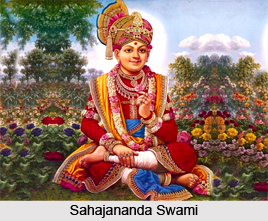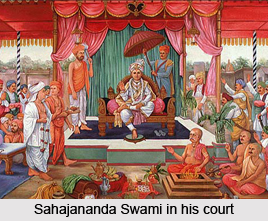 In the Swaminarayana faith of Hinduism, Sahajananda Swami or Swaminarayan is regarded as the central or the key figure of Hinduism and is also worshiped as the God. It is believed that five thousand years after Lord Krishna passed away, the age of Kali - darkness took place.
In the Swaminarayana faith of Hinduism, Sahajananda Swami or Swaminarayan is regarded as the central or the key figure of Hinduism and is also worshiped as the God. It is believed that five thousand years after Lord Krishna passed away, the age of Kali - darkness took place.
A cruel wicked evil contumaciously arose out of its proscription and the minds and hearts of the people started once again darkening. Within its grip eighteenth century India was suffocating. It resulted into separating vital nerves and arteries; it started haltering life, giving moral and spiritual nourishment, obstructing healthy growth of the eternal values like Dharma, Satya - truth, Ahimsa - non-violence and Brahmacharya - celibacy. On 3rd April 1781, Lord Krishna incarnated as Sashajananda Swami (Ghanshyam ) in order to bring harmony to this unrest. Until his death in 1830, he preached his doctrine of love, peace, purity and non-violence.
Sahajananda Swami also reckoned as Bhagwan Swaminarayan was born to a Sarvaria brahmin pundit Hariprasad Pande (Dharmadev) and his mother`s name was Premvati (Bhaktimata). As Ghanshyam Pande in the rural village of Chhapaiya, in northern India. Sahajananda Swami was the second of three sons and his elder brother was Rampratap, while, Ichharam was the younger brother.
According to a doctrine, after studying His zodiac signs, Markandeya (a sage astrologer) prophesied, "Since He is born in the Kark Rashi (in the zodiac sign of Cancer), His name will be Hari. His dark complexion will also confer the name Krishna and Ghanshyam. He has the virtues of tapas (austerity), detachment, yoga, Dharma, leadership, truth and vivek (power of discrimination). Therefore people will also call Him Neelkanth. He will establish Dharma on earth and remove pain and misery from people. He will be famed all over the land. He will also induce people with samadhi (a state of spiritual trance). He will lead people to the path of God."
To elude harassment from evil people, the family moved to nearby Ayodhya at Ghanshyam`s five years. At the age of 11, Sahajananda Swami left the home and traveled throughout India for 7 years on a holy pilgrimage. He has performed self-controls, the intensive tapas, meditation, and yoga in the Himalayas and was given the name `Neelkanth`.
After experiencing the misinterpretation and wrongful conduct of hinduism, travelled across India in search of an ashram or sampradaya (following) that exercised a correct apprehension of the four primary schools of Hinduism--- Vedanta, Samkhya, Yoga, and Pancaratra. As an unfathomed yogi, His journey eventually came to an end in Gujarat, to Swami Muktananda. Swami Muktananda was a senior monk-disciple of Swami Ramananda, an extremely esteemed Vaishnav guru and he answered all the five questions in a satisfactory manner.
The theoretical and epistemic concepts of five eternal entities, Pancha-Tattvas, combined with the Neelkanth`s level of mental and physical knowledge are said to have inspired even the senior sadhus of Swami Ramananda. With the graces of his Guru Sadguru Ramanand Swami, at the age of 21, he was entrusted the headship of the religious sect known as `Uddhav Sampraday`(later known as Swaminarayan Sampraday). Sahajananda Swami was taught the mantra after which He became known as `Bhagwan Swaminarayan`. At the time of induction into the monk order, He was given the name Swami Sahajananda by his Guru Swami Ramananda. He is commonly known as Bhagwan Swaminarayan, or Shreeji Maharaj or Shri Hari.
 People of all castes, doctrines, of a particular portion of Gujarat, Saurashtra, and even parts of Rajasthan were living under the false conceptions of the scriptures, which had led to a long-standing practice of superstitions, ferocity, and killing of animals in Vedic sacrifices (yagnas). Bhagwan Swaminarayan bought substantial transformation to their belief and as authentication of his philosophy of `temple theism and deity worship`, built nine splendid mandirs in: Ahmedabad, Bhuj, Muli, Vadtal, Junagadh, Dholera, Dholka, Gadhpur & Jetalpur. In those mandirs He established images of various clear appearance of God, such as NarNarayan Dev, LaxmiNarayan Dev, Radha Krishna, Radha Raman, Revti Baldevji, etc.
People of all castes, doctrines, of a particular portion of Gujarat, Saurashtra, and even parts of Rajasthan were living under the false conceptions of the scriptures, which had led to a long-standing practice of superstitions, ferocity, and killing of animals in Vedic sacrifices (yagnas). Bhagwan Swaminarayan bought substantial transformation to their belief and as authentication of his philosophy of `temple theism and deity worship`, built nine splendid mandirs in: Ahmedabad, Bhuj, Muli, Vadtal, Junagadh, Dholera, Dholka, Gadhpur & Jetalpur. In those mandirs He established images of various clear appearance of God, such as NarNarayan Dev, LaxmiNarayan Dev, Radha Krishna, Radha Raman, Revti Baldevji, etc.
"Vachanamrut" is the sacred and foundational scripture of the Swaminarayan faith, philosophical, social, and practical teachings. The acknowledgement of God`s manifestations is perhaps the most glorious aspects of the Hindu faith and in case of Sahajananda Swami his Devotees recognized Swaminarayan Bhagwan as Narayan, Rama, Krishna, etc. Swaminarayan Sampraday, the religious sect under the headship of Swaminarayan originates from the Ramanuja sampraday, which holds Lord Narayan to be supreme and Krishna to be an avatar. In his main work `Shikshapatri`, according to his belief Ishvara is Krishna and also `PraBrahma Bhagwan Purushottam`. He ornamented Krishna as the `cause of all manifestations and incarnations`
•"Vishista-advaita" means qualified non-dualism, is the Basic Principle of Swaminaryan Bhagawan. These are as propounded by Ramanujacharya:
•`Dharma` or Religion: As defined in the `Shrutis` and `Smrutis`, Holy Scriptures, it is the virtuous conduct.
•`Bhakti` or Devotion: `Bhakti` is the `supreme love of the soul combined with the consciousness of the glory of Supreme God`.
•`Jnana` or Enlightenment: Apt consciousness about the forms of the soul and about the illusion, and God iscalled Jnana.
•`Vairagya` or Renunciation: Out-and-out attachment towards God along with the separation from all material possessions is `Vairagya`.
•`Maya` or Illusion: Illusion that is there in all the three qualities like Satva, Rajas and Tamas.
•`Mukti - Moksha`: `Loving worship of God`.
•`Atman` or Self: Through bhakti-yoga, recognition of the atman, can be attained according to the Bhagavad Gita and also according to the teachings of Lord Swaminarayan.
•`Paramatman` or The Supreme Soul: `Paramatman` is omnipresent within the souls, it is independent and is the one whom rewards the `fala` (fruits) to the souls. According to his followers, `Paramatman` is manifested is Bhagwan Swaminarayan.
Bhagwan Swaminarayan prior to his death, made up one`s mind to find a line of acharyas, or preceptors as his spiritual successors to pass on his message to others and to preserve his fellowship. Two gadis were established in Ahmedabad (Shree Nar-Narayan Dev) and one in Vadtal (Shree Laxmi-Narayan Dev) on 21st November 1825. An acharya, from his immediate family to each of these two gadis were appointed. Bhagwan Swaminarayan ordained the office to be hereditary so that acharyas would maintain a direct line of blood descent from his family. He also specified an administrative division of the followers into two territorial jurisdictions in contrust to Hinduism. Sahajanand (Bhagwan Swaminarayan) had written this administrative division in minute detail in a document called, `Desh Vibhaag Lekh`.




















